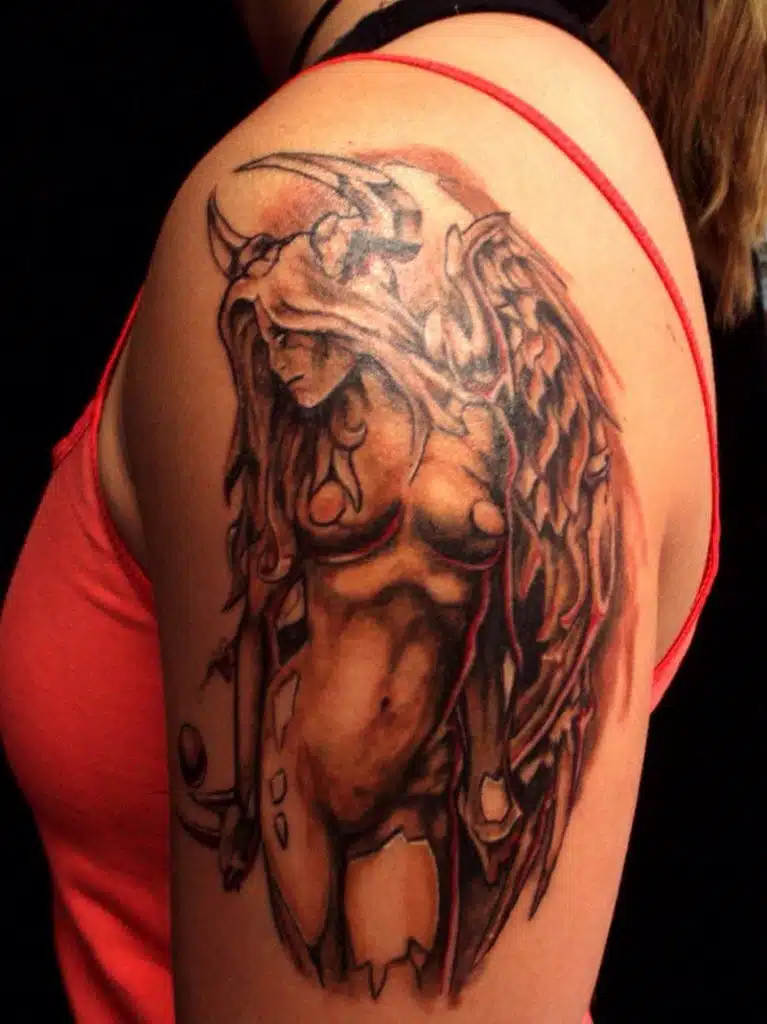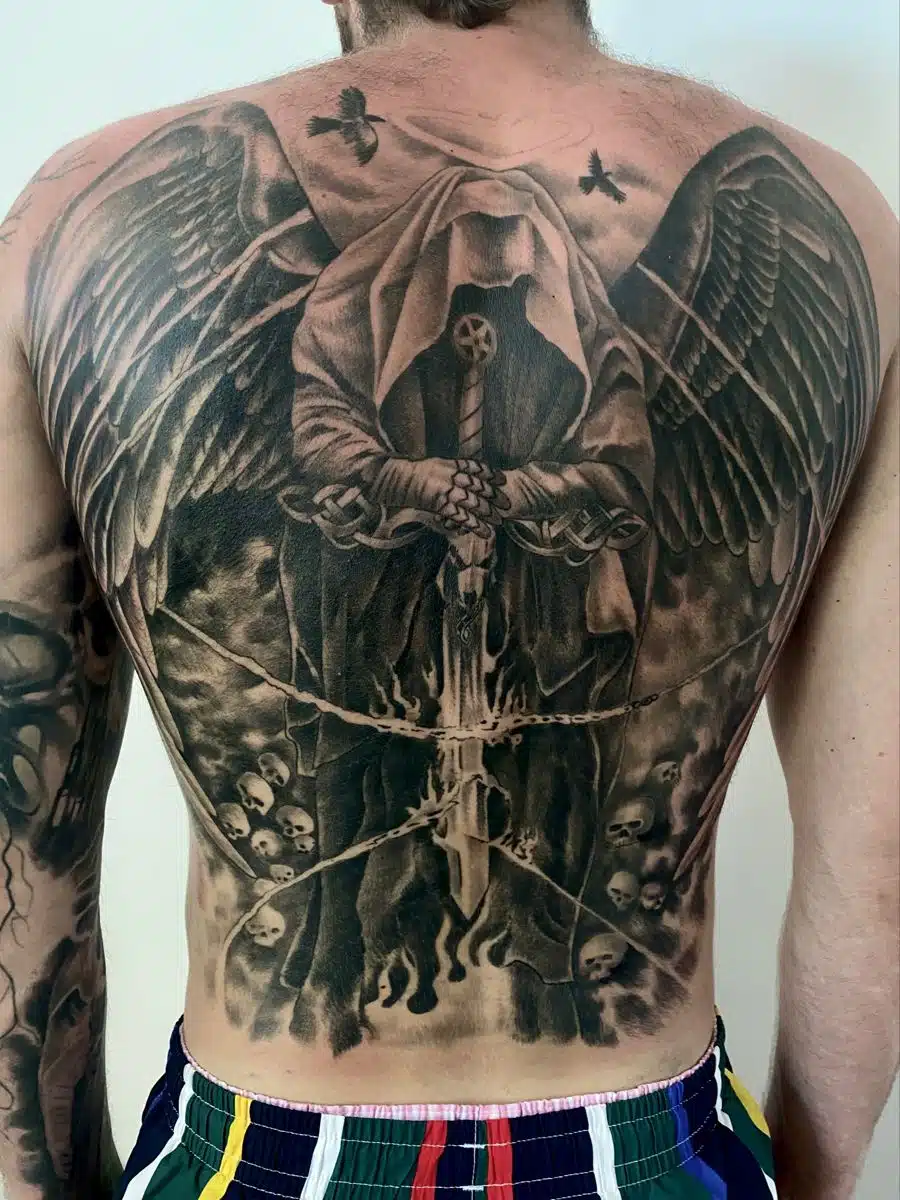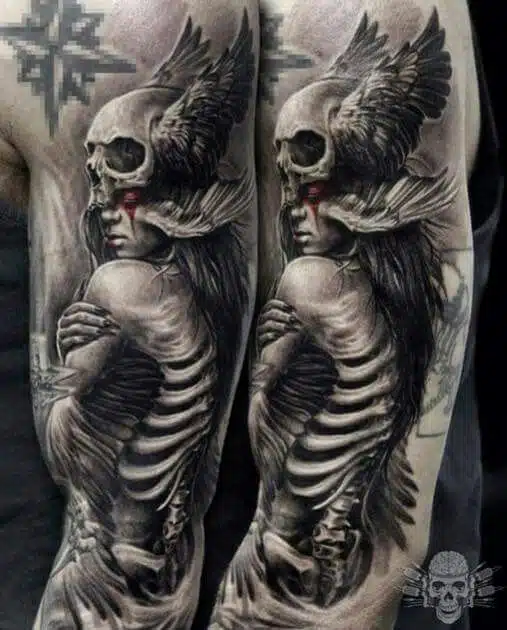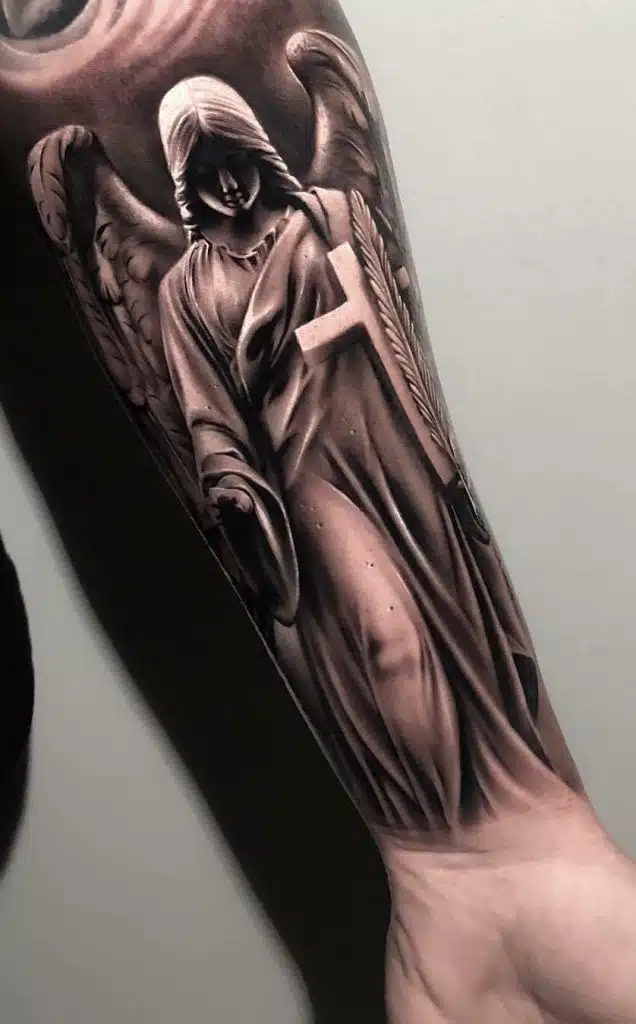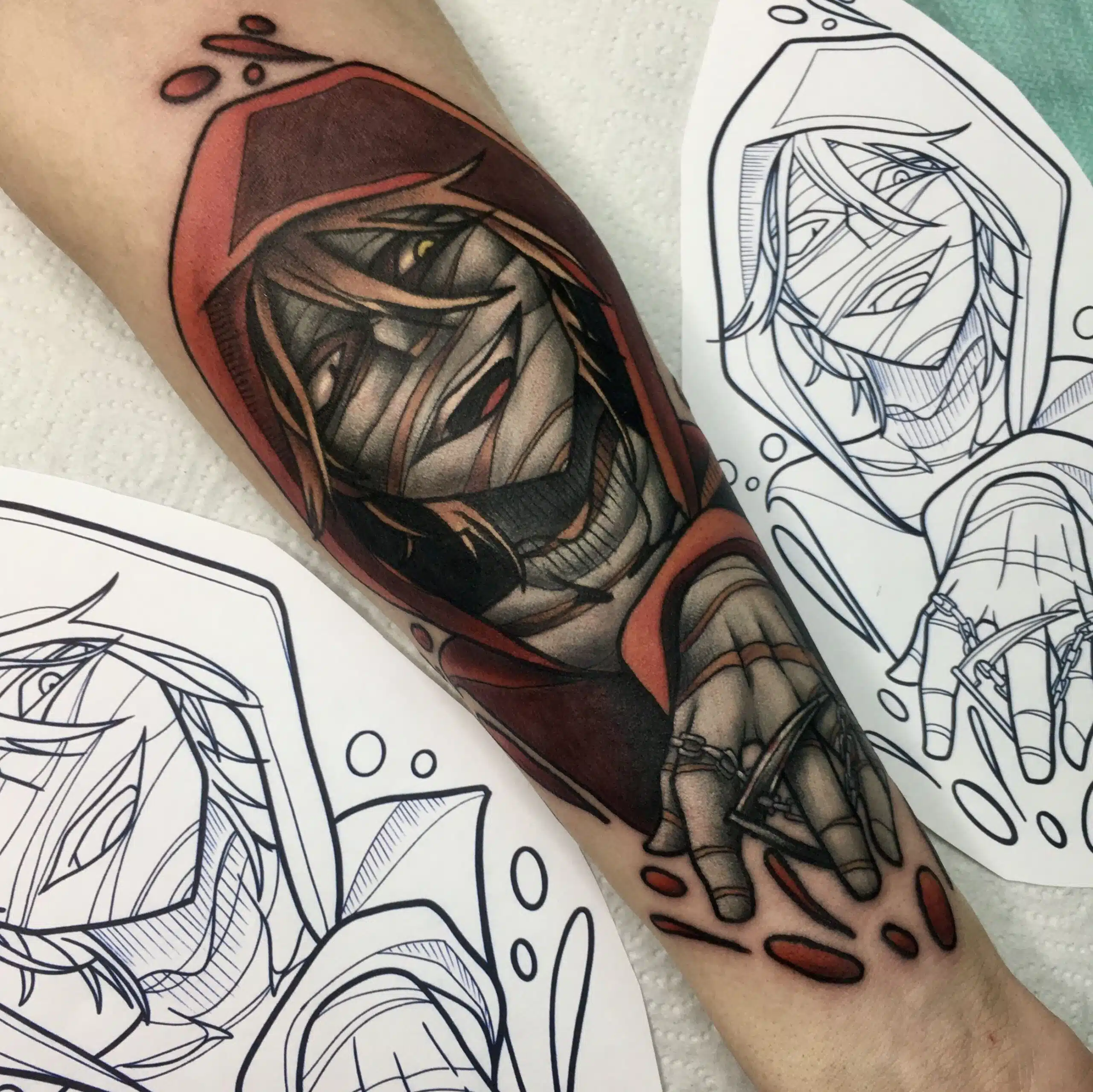When it comes to tattoos, there are a lot of choices to make. One popular design is the angel of death. This symbol can have many meanings depending on your personal beliefs and preferences. In this article, we will explore some of the different interpretations of this tattoo and provide some ideas for how you could incorporate it into your body art. We hope you enjoy it!
Are you only interested in tattoo designs and want to skip the educational part?
No problem, we got you covered! Click HERE to get inspired.
Who is the angel of death?
The term "angel of death" has been used in various religious, mythological, and cultural contexts to refer to different figures associated with death or the act of dying. Here are a few notable examples:
Azrael: In Islamic tradition, Azrael is often referred to as the angel of death. He is believed to be responsible for separating the soul from the body at the time of death.
Samael: In some Jewish and Christian traditions, Samael is associated with the angel of death or the grim reaper. He is often depicted as a fallen angel or demon.
Valkyries: In Norse mythology, the Valkyries were female figures who decided the fate of warriors in battle. They were sometimes considered angelic figures and were associated with both life and death.
Santa Muerte: In certain folk religions and spiritual practices, particularly in Mexico, Santa Muerte ("Holy Death") is venerated as a female skeletal figure associated with death and protection.
It's important to note that the concept of the angel of death can vary greatly across different cultures, religions, and belief systems. The specific figure and characteristics associated with the angel of death may differ depending on the context in which it is mentioned.
What does an angel of death symbolize?
The symbolism associated with the Angel of Death can vary depending on cultural, religious, and mythological beliefs. Here are some common interpretations and symbolisms:
Transition and Passage: The Angel of Death often symbolizes the transition from life to death. It represents the final stage of life's journey and the passage from the mortal realm to the afterlife or spiritual realm.
Divine Messenger: In many traditions, the Angel of Death is seen as a messenger from a higher power, responsible for carrying out the divine will and guiding souls to their next destination.
Endings and Transformation: The presence of the Angel of Death can symbolize the end of a particular phase or cycle. It represents the inevitability of death and the transformation that occurs as one moves from one state of being to another.
Judgment and Justice: In certain belief systems, the Angel of Death is associated with judgment and the weighing of one's deeds or karma. It signifies the reckoning of a person's actions in life and the dispensation of justice in the afterlife.
Liberation and Release: For some, the Angel of Death symbolizes liberation and release from the sufferings of earthly existence. It can be seen as a figure that brings relief, peace, and freedom from the limitations and trials of mortal life.
What Does the Angel Of Death Tattoo Symbolize?
The meaning and symbolism of an Angel of Death tattoo can vary depending on the individual's personal interpretation and intention behind getting the tattoo. Here are some common symbolisms associated with Angel of Death tattoos:
Mortality and Transience: An Angel of Death tattoo can serve as a reminder of the fleeting nature of life and the inevitability of death. It can symbolize an acknowledgment and acceptance of the finite nature of human existence.
Protection and Guidance: Some people may choose an Angel of Death tattoo as a symbol of protection and guidance through the journey of life and death. It can represent a belief in a higher power watching over and guiding them through difficult times.
Rebirth and Transformation: The Angel of Death tattoo can also symbolize the concept of rebirth and transformation. It can be a reminder of the cyclical nature of life, where death leads to new beginnings and personal growth.
Balance and Duality: The Angel of Death tattoo can embody the idea of balancing life and death, light and darkness, and the delicate equilibrium between opposing forces. It can represent a recognition of the interconnectedness and harmony of these dualities.
Individual Interpretation: Ultimately, the symbolism of an Angel of Death tattoo is subjective and can be unique to each person. The meaning may be deeply personal, reflecting their own beliefs, experiences, or associations with death and spirituality.
It's crucial to remember that tattoos hold personal significance, and the symbolism of an Angel of Death tattoo can differ from person to person. It's essential to approach tattoo designs with thoughtfulness and ensure they resonate with your own values and intentions.
What does the angel of death represent in Christianity?
In Christianity, the angel of death is often associated with the end times. This is when Jesus will return to Earth, and all of humanity will be judged. The angel of death will separate the righteous from the wicked and escort them to their respective afterlife destinations.
What does the angel of death represent in Islam?
In Islam, the angel of death is known as Azrael. He is responsible for taking the souls of all humans when it is their time to die by separating the souls from their bodies.
Azrael is often described as being very tall and having a countenance that is both gentle and stern. He is one of the four archangels (with Jibrīl, Mīkāl, and Isrāfīl) and the Islamic counterpart of the Judeo-Christian angel of death, who is sometimes called Azrael.
What does the angel of death represent in Hinduism?
In Hinduism, the angel of death is known as Yama. He is the son of the Sun god and the twin brother of Yamuna (the goddess of the river Yamuna). Yama is the lord of death and justice and presides over the southern direction. He is often depicted as a green-skinned man riding on a black buffalo.
best Angel of death tattoo ideas and their meanings
Now that we have explored some of the different interpretations of this tattoo let's look at some ideas for how you could incorporate it into your body art.
Female angel of death tattoo
A female angel of death tattoo can symbolize many things, such as strength in the face of adversity, protection from harm, or the ability to overcome obstacles.
Angel of death tattoo with wings
This can represent protection, hope, or a connection to the divine. You could also use this tattoo to represent your beliefs about the afterlife.
Azrael angel of death tattoo
This tattoo reminds us of our mortality and the transitory nature of life. It can also represent our belief in an afterlife and the hope that comes with it.
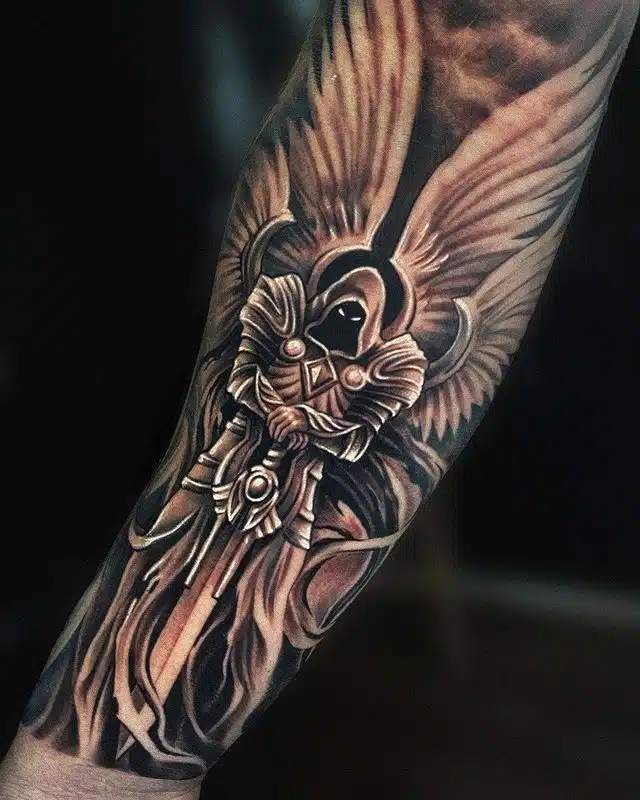
Viking angel of death tattoo
This tattoo can symbolize strength, courage, and the ability to face death with honor. It can also represent a connection to Norse mythology and the Viking way of life.
Guardian angel tattoo
A guardian angel tattoo can offer protection and guidance. It can also represent our belief in the power of good over evil.
Grim reaper tattoo
This tattoo can represent any discussed meanings. It is popular for those who want a religious or spiritual tattoo.
Angels of death anime tattoo
This tattoo is a popular choice for fans of Japanese animation. It can represent the characters' struggles with mortality or their belief in an afterlife.
As you can see, there are many different ways that you can interpret an angel of death tattoo. Whether you see it as a reminder of your own mortality or a symbol of hope and protection, this tattoo can be a powerful and personal addition to your body art.
General Breakdown Of Tattoo Pain Levels On Different Body Parts
Here is a breakdown of the different tattoo pain levels:
- Low: This level of pain is generally described as a mild discomfort or tickling sensation. It is similar to the sensation of getting a light scratch or scrape.
- Moderate: This level of pain is generally described as a moderate discomfort or aching sensation. It is similar to the sensation of getting a deep scratch or scrape or being pinched.
- High: This level of pain is generally described as a strong discomfort or throbbing sensation. It is similar to the sensation of getting a burn or being stung by a bee.
It's important to note that pain tolerance is highly individual and can vary greatly from person to person. Some people may find certain body parts more or less painful than others, and the same body part can be more or less painful for different people. Additionally, the level of pain can be affected by factors such as the size and location of the tattoo, the skill of the tattoo artist, and the individual's own pain threshold.
Tattoo placement pain level chart
Body Part | Pain Level | Explanation |
Forehead | Low | The forehead has few nerve endings, so it is not a particularly painful area. |
Eyebrows | Low | The eyebrows have few nerve endings, so the pain level is relatively low. |
Ear | Low | The ear is a relatively thin and fleshy area, so the pain level is low. |
Nostril | Low | The nostril is a small area with thin skin, so the pain level is low. |
Lip | Low to Moderate | The lip has more nerve endings than some other areas, so it may be slightly more painful. |
Cheek | Low to Moderate | The cheek has a moderate amount of nerve endings, so it may be slightly more painful. |
Moderate | The neck has a moderate amount of nerve endings, so it may be slightly more painful. | |
Moderate to High | The chest has a high concentration of nerve endings, so it can be quite painful. | |
Abdomen | High | The abdomen has a high concentration of nerve endings, so it can be quite painful. |
Back | High | The back has a high concentration of nerve endings, so it can be quite painful. |
Shoulders | High | The shoulders have a high concentration of nerve endings, so they can be quite painful. |
Upper Arms | Moderate to High | The upper arms have a moderate to high concentration of nerve endings, so they can be somewhat painful. |
Elbows | High | The elbows have a high concentration of nerve endings, so they can be quite painful. |
Forearms | Moderate | The forearms have a moderate concentration of nerve endings, so they are not as painful as some other areas. |
Hands | High | The hands have a high concentration of nerve endings, so they can be quite painful. |
Lower Arms | Low to Moderate | The lower arms have a lower concentration of nerve endings, so they are not as painful as some other areas. |
Wrists | Low | The wrists have a low concentration of nerve endings, so they are not very painful. |
Lower Back | High | The lower back has a high concentration of nerve endings, so it can be quite painful. |
Buttocks | High | The buttocks have a high concentration of nerve endings, so they can be quite painful. |
Thighs | High | The thighs have a high concentration of nerve endings, so they can be quite painful. |
Knees | High | The knees have a high concentration of nerve endings, so they can be quite painful. |
Calves | Low to Moderate | The calves have a low to moderate concentration of nerve endings, so they are not as painful as some other areas. |
Ankles | Low | The ankles have a low concentration of nerve endings, so they are not very painful. |
Tattoo aftercare tips
Before getting a tattoo:
Choose a reputable tattoo artist and parlor. Research the artist's portfolio and read reviews from previous clients.
Consult with the artist about the design and placement of the tattoo.
Make sure you are in good health. If you have any medical conditions or are taking any medications that may affect your ability to heal, be sure to let your tattoo artist know.
Consider using a numbing cream to reduce pain during the tattooing process. These creams contain a numbing agent (such as lidocaine) that can be applied to the skin before the tattoo is done. It's important to follow the instructions on the numbing cream and to only use it as directed.
Avoid alcohol, caffeine, and other substances that can thin your blood for at least 24 hours before getting a tattoo.
Eat a healthy meal before your tattoo session to ensure that your blood sugar is stable.
Wear loose, comfortable clothing that allows easy access to the area being tattooed.
After getting a tattoo:
Follow the aftercare instructions provided by your tattoo artist. These may include:
Keeping the tattoo clean and covered with a bandage for the first few hours after getting tattooed.
Washing the tattoo with lukewarm water and a mild soap (such as unscented, antimicrobial soap) and patting it dry with a clean towel.
Applying a thin layer of tattoo ointment or lotion (such as A&D or Aquaphor) to the tattoo and covering it with a clean bandage or wrap.
Repeating this process for the first few days, or until the tattoo has fully scabbed over.
Avoid soaking the tattoo in water for the first week, such as in a bath or pool.
Avoid picking or scratching at the scabs, as this can cause the tattoo to fade or become infected.
Avoid exposure to direct sunlight or tanning beds for at least 2-4 weeks.
If you experience any redness, swelling, or unusual discharge, contact your tattoo artist or a healthcare professional.
Overall, it's important to keep your tattoo clean and moisturized during the healing process to ensure that it heals properly and looks its best. Using a numbing cream can help reduce pain during the tattooing process, but it's important to use it as directed and to follow all aftercare instructions to ensure that your tattoo heals properly.
People Also Ask:
What does the Archangel tattoo mean?
Many people choose to tattoo Archangel Michael on their bodies as he is said to bring courage, protection, and guidance. Many people get Archangel Michael tattoos because he is the leader of all Archangels. He also offers courage, protection, and guidance.
Why do people get angel tattoos?
People often get angel tattoos as a reminder of their mortality or a symbol of hope and protection. Some people choose to tattoo an angel on their body because they believe in the power of good over evil.
What is the most popular tattoo?
The most popular tattoo in the world is The Cross. It is estimated that one out of every three people worldwide has a cross tattoo. The second most popular tattoo is The Angel. It is estimated that one out of every four people worldwide has an angel tattoo.
What does it mean when an angel touches your head?
When an angel touches your head, it is a sign of protection. Angels are often seen as protectors and guides, so this gesture can be seen as a reminder that you are not alone.
What is the meaning of an angel with broken wings?
An angel with broken wings can represent many things, such as strength in the face of adversity, the ability to overcome obstacles, or protection from harm. It can also represent our belief in the power of good over evil.
What does it mean when you see an angel?
When you see an angel, it is said to be a sign of protection. Angels are often seen as protectors and guides, so this can be a reminder that you are not alone. It can also represent our belief in the power of good over evil.
Watch A Time-Lapse Video Of An Angel of Death Tattoo Done By A Pro:
199+ Angel of Death Tattoo Ideas for You to Get Inspired
Final thoughts:
When choosing an angel of death tattoo, it is important to consider what the tattoo means to you. There are many interpretations of this tattoo, so take the time to choose a design that represents your personal beliefs. An angel of death tattoo can be a beautiful and powerful addition to your body art collection.

